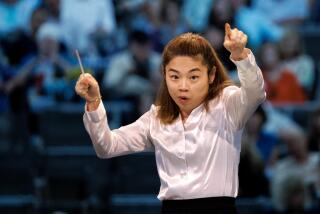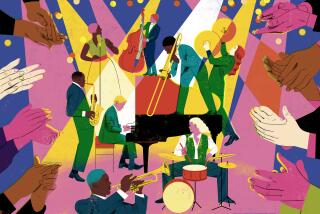Pieces of New Orleans
The premise of “The Real Thing,” Wednesday night’s Lexus Jazz at the Bowl program, was a good one. “A celebration of the birthplace of jazz, New Orleans” is how the event was described by John Clayton, one of the co-leaders of the Clayton-Hamilton Jazz Orchestra and artistic director of jazz for the L.A. Philharmonic.
Somewhere between the concept and the concert, however, something went awry. For one thing, the Clayton-Hamilton Orchestra opened the performance with a program of five tunes possessing no visible connection with New Orleans. And the presence of Billy Higgins and Louis Bellson on the bill, as well as the participation by young drummers Kevin Kanner and Marco Meheghin (winners of Philharmonic Awards in Education) slanted a good portion of the program in the direction of jazz percussion.
As it turned out, there were good aspects to both those factors. The CHJO’s opening set--despite its absence of New Orleans references--included some fine playing from this superb ensemble. And the climactic number, a Clayton original titled “Plunger Mute Syndrome” that showcased the remarkable young trombonist Isaac Smith’s highly individualistic plunger mute style, was a particularly effective combining of soloist and orchestra.
Although the drumming passages had their moments of excess, a segment in which Higgins, Bellson, Kanner and Meheghin were joined by CHJO co-leader Jeff Clayton for a five-drum, collective rendering of “Salt Peanuts” made it all worthwhile. The exchanges between the five drummers--alternatingly virtuosic, swinging and humorous--provided one of the program’s high points.
Pianist-singer Dr. John (Mac Rebennack) and trumpeter Byron Stripling were the New Orleans headliners, and each managed to generate an atmospheric, Crescent City feeling. Dr. John was effective--especially on two of his hit numbers, “Right Place, Wrong Time” and “Such a Night”--in producing an irrepressible gumbo of Cajun rhythms, blues, jazz and funk. And Stripling, a stirring instrumentalist, delivered a group of numbers--”Tiger Rag” and “Do You Know What It Means to Miss New Orleans” among them--with a distinct Louis Armstrong flavor.
So call it a program in which all the individual pieces worked just fine, even though they never quite came together into a coherent whole--at least not one that fully encompassed the concert’s self-described New Orleans ambitions.
More to Read
The biggest entertainment stories
Get our big stories about Hollywood, film, television, music, arts, culture and more right in your inbox as soon as they publish.
You may occasionally receive promotional content from the Los Angeles Times.










